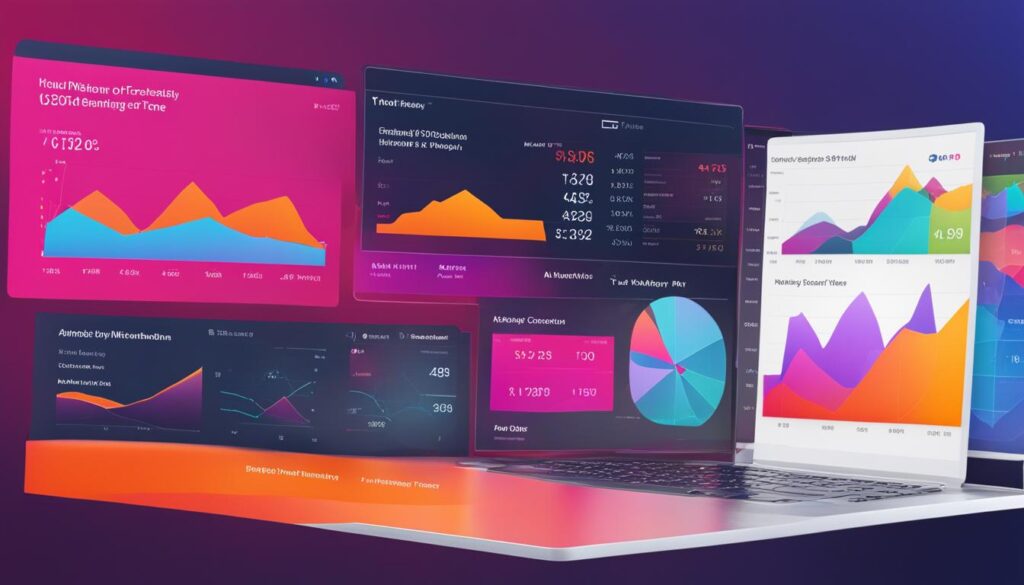Creating and managing budgets is an essential aspect of financial planning for any organization. However, the traditional budgeting process can sometimes lead to control issues that can negatively impact your fiscal health. This control paradox arises from the time-consuming nature of creating a detailed annual budget, which often results in outdated information and missed opportunities.
Key Takeaways:
- Control issues in budgeting can have a significant impact on your fiscal health.
- The traditional budgeting process can lead to a control paradox, where the more time and effort spent on creating a detailed budget, the quicker it may lose its relevance.
- Adopting agile budgeting models such as rolling forecasts and zero-based budgeting can help overcome control issues.
- Embracing technology and advanced solutions can optimize the budgeting process and improve accuracy.
- It is crucial to mitigate the illusion of control bias in budgeting by focusing on evidence-based strategies and seeking diverse perspectives.
Challenges in the Traditional Budgeting Process
The traditional budgeting process presents several challenges that organizations need to navigate in order to ensure effective financial planning and control. These challenges include budgeting factors, data collection, spreadsheets, collaborative efforts, and market changes.
Budgeting factors
Data collection and analysis are crucial components of the budgeting process. Organizations need to gather historical data, project future revenue, and account for various factors that may impact financial performance. This includes factors such as sales trends, market conditions, inflation rates, and other economic indicators.
Data collection
Data collection can be a time-consuming and complex undertaking. Organizations often rely on spreadsheets to compile and analyze financial data. However, spreadsheets can introduce errors and version control issues, especially when multiple individuals are involved in the budgeting process.
Collaborative efforts
Budgeting requires collaborative efforts from various departments within an organization. It involves aligning goals, gathering input from different stakeholders, and obtaining approvals from higher-level management. This collaborative process can result in lengthy review cycles and potential delays in finalizing the budget.
Market changes
Market conditions are constantly evolving, and organizations need to consider these changes when developing their budgets. Unexpected shifts in customer preferences, competitive landscapes, or economic factors can impact revenue projections and financial targets. Budgets need to be flexible enough to accommodate unforeseen market changes and enable swift decision-making.
| Challenges | Impact |
|---|---|
| Budgeting Factors | Complexity in gathering and analyzing data |
| Data Collection | Potential errors and version control issues |
| Collaborative Efforts | Lengthy review cycles and potential delays |
| Market Changes | Impact on revenue projections and financial targets |
The Consequences of a Slow Budgeting Process
A slow budgeting process can have severe consequences for an organization’s financial health and overall performance. One of the main drawbacks of a slow budgeting process is that it often relies on outdated information. As the budgeting process takes a long time from creation to final approval, the market conditions and business dynamics might have changed, rendering the budget irrelevant and inaccurate.
This can lead to missed opportunities for new investments and adjustments to market shifts. With outdated information, businesses may make poor financial decisions, such as allocating resources to the wrong areas or investing in projects that are no longer viable. Additionally, relying on an old budget can expose businesses to unfavorable currency fluctuations and misjudged credit risks, further impacting their fiscal health.
In a fast-paced and competitive market environment, businesses need to be able to adapt quickly. A slow budgeting process hinders their ability to respond effectively to changing market conditions and seize new opportunities, putting them at a significant disadvantage compared to their more agile competitors.
| Consequences of a Slow Budgeting Process | Impact |
|---|---|
| Outdated Information | Lack of accuracy in financial forecasts |
| Missed Opportunities | Inability to capitalize on new investments and market shifts |
| Poor Financial Decisions | Allocation of resources to the wrong areas and exposure to unfavorable currency fluctuations |
To mitigate these consequences, organizations need to streamline their budgeting process and incorporate more agile and responsive approaches. Embracing technology and advanced solutions can help optimize the budgeting process, allowing for real-time data integration and quicker decision-making. It is essential for organizations to prioritize accuracy, adaptability, and proactive financial planning to ensure their fiscal health and competitiveness in today’s dynamic market landscape.
Agile Budgeting Models to Overcome Control Issues
Traditional budgeting processes can create control issues due to their static nature, resulting in outdated information and missed opportunities. To address these challenges, organizations are adopting more agile budgeting models that allow for greater flexibility and responsiveness. Two popular approaches are rolling forecasts and zero-based budgeting.
Rolling Forecasts
Rolling forecasts provide a constantly updated look at future performance, allowing businesses to adapt quickly to market changes. Instead of relying on a fixed annual budget, rolling forecasts continually project financial performance based on the most current data and insights. This approach enables organizations to adjust their financial plans as needed, minimizing the risk of making decisions based on outdated information.
Zero-Based Budgeting
Zero-based budgeting involves creating multiple budget versions for different scenarios and regularly updating them based on the latest data. With zero-based budgeting, organizations start each period with a “blank slate,” requiring them to justify and prioritize every expense. This approach promotes a more thorough evaluation of spending priorities and encourages cost-conscious decision-making. By regularly reviewing and updating the budget, organizations can stay aligned with changing market conditions and optimize their resource allocation.
Integrated Business Planning
In addition to rolling forecasts and zero-based budgeting, integrated business planning is another agile model that helps organizations overcome control issues. This approach aligns budgeting with the larger strategic vision and operational needs of the business. By integrating financial planning, demand planning, and supply chain management, organizations can create a more holistic and comprehensive budgeting process. This alignment ensures that financial decisions are grounded in the overall business strategy and helps organizations achieve their financial goals.
Table: Comparison of Agile Budgeting Models
| Agile Budgeting Model | Key Features | Benefits |
|---|---|---|
| Rolling Forecasts | Constantly updated projections based on current data | Adaptability to market changes, reduced reliance on outdated information |
| Zero-Based Budgeting | Regularly updated budgets for different scenarios | Thorough evaluation of spending priorities, cost-conscious decision-making |
| Integrated Business Planning | Alignment of budgeting with overall business strategy | Comprehensive and holistic financial planning, strategic decision-making |
The Role of Advanced Solutions in Budgeting
As organizations strive to overcome control issues in budgeting, advanced solutions are playing a crucial role in streamlining the process and enhancing financial planning capabilities. AI-powered forecasting software, data analytics platforms, and financial planning and analysis solutions are revolutionizing the way budgets are created and managed.
AI-powered forecasting software enables businesses to leverage advanced algorithms and machine learning to generate accurate and insightful forecasts. These solutions analyze historical data, market trends, and other relevant factors to provide real-time insights into future performance. By harnessing the power of AI, organizations can make more informed decisions and adjust their financial plans to align with changing market conditions.
“AI-powered forecasting software enables businesses to leverage advanced algorithms and machine learning to generate accurate and insightful forecasts.”
Data analytics platforms play a vital role in budgeting by providing organizations with a comprehensive view of their financial data. These platforms enable businesses to analyze large volumes of data quickly and efficiently, identifying trends, patterns, and anomalies that can impact budgeting decisions. With data analytics platforms, organizations can make data-driven decisions and gain a deeper understanding of their financial position, enabling better resource allocation and risk management.
The Benefits of Financial Planning and Analysis Solutions
Financial planning and analysis solutions, driven by artificial intelligence, offer a range of benefits for organizations. These solutions provide comprehensive financial modeling capabilities, allowing businesses to create multiple budget versions for different scenarios. With real-time data integration and advanced analytics capabilities, these solutions enable organizations to optimize their financial plans, evaluate various strategies, and make proactive decisions based on accurate and timely information.
In conclusion, advanced solutions such as AI-powered forecasting software, data analytics platforms, and financial planning and analysis solutions are transforming the budgeting process. These tools empower organizations with the ability to generate accurate forecasts, analyze financial data effectively, and make informed decisions. By leveraging the power of technology, businesses can navigate the challenges of control issues in budgeting and optimize their financial planning for improved fiscal health.
| Advanced Solutions | Benefits |
|---|---|
| AI-powered forecasting software | – Accurate and insightful forecasts – Real-time insights into future performance |
| Data analytics platforms | – Comprehensive view of financial data – Data-driven decisions – Better resource allocation and risk management |
| Financial planning and analysis solutions | – Range of financial modeling capabilities – Real-time data integration – Advanced analytics for proactive decision-making |

Embracing Technology for Detailed and Agile Budgeting
In today’s fast-paced business environment, organizations need to find a balance between detailed budgeting and the agility to adapt to market changes. Embracing technology is the key to achieving this delicate balance. By leveraging advanced solutions, businesses can streamline their budgeting process, enhance accuracy, and enable proactive decision-making.
Advanced solutions such as AI-powered forecasting software and data analytics platforms offer real-time insights and automation capabilities that accelerate the budgeting process. These tools eliminate the need for manual data entry and provide robust analytics, enabling organizations to make data-driven financial projections and forecasts. With accurate and up-to-date information at their fingertips, businesses can adjust their budgets dynamically to align with market shifts and evolving business goals.
Technology is revolutionizing the way businesses approach budgeting. With the integration of advanced solutions, organizations can achieve both detailed and agile budgeting, allowing them to navigate the challenges of control issues and optimize their financial planning.
Moreover, embracing technology allows for improved collaboration across departments. With cloud-based platforms, teams can work together in real-time, eliminating version control issues and ensuring everyone is on the same page. This collaborative approach enhances goal alignment and approval hierarchies, reducing review cycles and increasing efficiency in the budgeting process.
By embracing technology, businesses can navigate the control paradox and achieve accurate financial planning through detailed and agile budgeting. The integration of advanced solutions empowers organizations to make informed decisions, adapt quickly to market changes, and optimize their overall financial performance.
| Benefits of Embracing Technology for Budgeting |
|---|
| Enhanced accuracy and automation |
| Real-time insights and analytics |
| Dynamic budget adjustments |
| Improved collaboration and efficiency |
By leveraging technology, organizations can overcome the control paradox in budgeting and achieve the balance of detailed and agile budgeting required for success in today’s dynamic business landscape.

Mitigating the Illusion of Control Bias in Budgeting
When it comes to budgeting, the illusion of control bias can often cloud judgment and lead to suboptimal investment decisions. To overcome this bias, organizations need to adopt evidence-based strategies that promote a more rational and objective approach to financial planning. One of the key strategies is diversification. By spreading investments across different asset classes and sectors, businesses can reduce their exposure to idiosyncratic risk and minimize the impact of market fluctuations on their overall financial performance.
Another important aspect to consider is maintaining a long-term perspective. It’s easy to get caught up in short-term trends and try to time the market, but this approach rarely leads to sustainable success. By focusing on long-term goals and investment horizons, businesses can avoid the temptation to make impulsive decisions based on short-term market movements. This allows for a more comprehensive and strategic approach to budgeting that considers the broader financial landscape.
“Diversification is an essential tool in mitigating the illusion of control bias. By spreading investments across different asset classes, businesses can reduce their exposure to risk and make more informed decisions.” – Finance Expert
Finally, seeking diverse perspectives and expertise from professionals in finance and investment can also help mitigate the illusion of control bias. By involving individuals with different backgrounds and experiences, businesses can benefit from a broader range of insights and ideas. This can lead to more robust financial planning and a better understanding of the potential risks and opportunities that lie ahead.
| Benefits of Mitigating the Illusion of Control Bias | Strategies |
|---|---|
| Reduced exposure to idiosyncratic risk | Diversification |
| Long-term perspective | Maintaining a focus on long-term goals |
| Broader range of insights and ideas | Seeking diverse perspectives and expertise |
By implementing these evidence-based strategies and embracing a more rational approach to budgeting, businesses can mitigate the illusion of control bias and make more informed financial decisions. This ultimately leads to better financial optimization and a stronger foundation for long-term success.

Conclusion
Control issues in budgeting can significantly impact your fiscal health. The traditional budgeting process often leads to a control paradox, where the more time you spend creating a detailed budget, the quicker it becomes outdated. To overcome these challenges and optimize your financial planning, organizations are adopting agile budgeting models such as rolling forecasts and zero-based budgeting.
Embracing technology is key to financial optimization. Advanced solutions like AI-powered forecasting software and data analytics platforms revolutionize the budgeting process, providing quick insights, improving collaboration, and enabling proactive decision-making. By integrating these technologies, businesses can achieve both detailed and agile budgeting, adapting quickly to market changes.
Furthermore, mitigating the illusion of control bias is crucial for making sound investment decisions. By focusing on evidence-based strategies, such as diversification and maintaining a long-term perspective, you can reduce idiosyncratic risk and avoid the pitfalls of market timing or overtrading. Seeking diverse perspectives from finance professionals can also help mitigate this bias.
By understanding the control issues in budgeting, adopting agile budgeting models, leveraging advanced solutions, and mitigating the illusion of control bias, you can optimize your financial planning and navigate the challenges of budgeting with confidence. Embrace the power of technology and evidence-based strategies to achieve financial success.
FAQ
What are the challenges in the traditional budgeting process?
The traditional budgeting process involves factors such as data collection, spreadsheets, and collaborative efforts, which can be time-consuming and prone to errors.
What are the consequences of a slow budgeting process?
A slow budgeting process can result in budgets based on outdated information, leading to missed opportunities, poor financial decisions, and exposure to risks.
How can agile budgeting models help overcome control issues?
Agile budgeting models such as rolling forecasts and zero-based budgeting provide flexibility and allow businesses to adapt quickly to market changes.
What is the role of advanced solutions in budgeting?
Advanced solutions such as AI-powered forecasting software and data analytics platforms help speed up work, provide insights, and improve collaboration.
How can technology help navigate the control paradox in budgeting?
Embracing technology enables businesses to achieve detailed and agile budgeting, optimize financial planning, and make proactive decisions.
How can the illusion of control bias be mitigated in budgeting?
The illusion of control bias can be mitigated by focusing on evidence-based strategies, diversification, and maintaining a long-term perspective.
How Does Social Comparison Impact Control Issues in Budgeting?
Social comparison can significantly impact control issues in budgeting. When individuals compare their financial situation to others’, it can lead to feelings of inadequacy or the need to keep up with unrealistic standards. This can result in overspending, debt accumulation, and a lack of control over one’s budget. It’s important to focus on personal financial goals and adapt practices that prioritize financial well-being, rather than succumbing to the pressures of social comparison and your budget.

